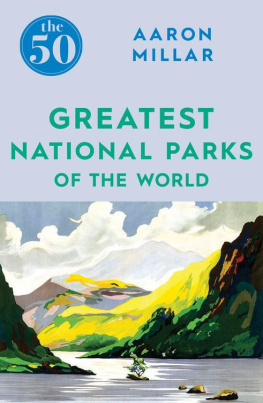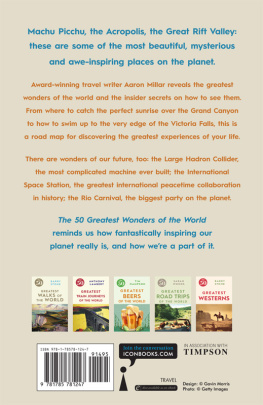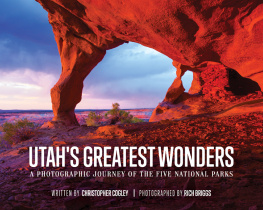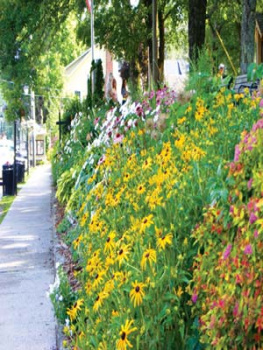Aaron Millar - The 50 Greatest National Parks of the World
Here you can read online Aaron Millar - The 50 Greatest National Parks of the World full text of the book (entire story) in english for free. Download pdf and epub, get meaning, cover and reviews about this ebook. year: 2018, publisher: Icon Books Ltd, genre: Romance novel. Description of the work, (preface) as well as reviews are available. Best literature library LitArk.com created for fans of good reading and offers a wide selection of genres:
Romance novel
Science fiction
Adventure
Detective
Science
History
Home and family
Prose
Art
Politics
Computer
Non-fiction
Religion
Business
Children
Humor
Choose a favorite category and find really read worthwhile books. Enjoy immersion in the world of imagination, feel the emotions of the characters or learn something new for yourself, make an fascinating discovery.
- Book:The 50 Greatest National Parks of the World
- Author:
- Publisher:Icon Books Ltd
- Genre:
- Year:2018
- Rating:4 / 5
- Favourites:Add to favourites
- Your mark:
- 80
- 1
- 2
- 3
- 4
- 5
The 50 Greatest National Parks of the World: summary, description and annotation
We offer to read an annotation, description, summary or preface (depends on what the author of the book "The 50 Greatest National Parks of the World" wrote himself). If you haven't found the necessary information about the book — write in the comments, we will try to find it.
The 50 Greatest National Parks of the World — read online for free the complete book (whole text) full work
Below is the text of the book, divided by pages. System saving the place of the last page read, allows you to conveniently read the book "The 50 Greatest National Parks of the World" online for free, without having to search again every time where you left off. Put a bookmark, and you can go to the page where you finished reading at any time.
Font size:
Interval:
Bookmark:
Formy children, Cameron and Elise
This Ill Defend
The descriptions given in these articles are for general guidance only, and should not be used as a substitute for a proper travel guide or route plan. Neither the author nor the publisher shall be liable or responsible for any loss, injury or damage allegedly arising from any information contained in this book. In terms of the organisation of this book, Greenland has been placed in the European section, although it is geographically a part of North America, because it is an autonomous territory of Denmark and most major access points are through European countries. Similarly, Georgia, which is considered to be on the crossroads of Europe and Asia, has been placed in the Asia section, though it could equally have been included in Europe.
- THE 50 GREATEST NATIONAL PARKS OF THE WORLD
John Muir, the great environmentalist, said: Going to the mountains is going home. The wilderness isnt a luxury; it isnt a pretty postcard or a quick photograph from a car window screen. Its an essential part of who we are. Ninety nine per cent of the evolution of humankind has been spent intimately connected with the outdoors. Only in the last 10,000 years have we turned to settlements and cultivated land, and only in the last few hundred have those spiralled into the metropolises we see today.
You may spend your days in front of a computer screen, you may live in a city, or have never stood on a mountain summit or seen the true glory of the stars at night, but make no mistake: the wilderness is inside of you. If this book aspires to an idea it is this: love your world, live life to the full and feed your wildness well.
The first national park, Yellowstone, was established in 1872. It was an era of human domination over nature, and so the idea that wild lands should be set aside for conservation was a radical one. But it spread. According to the International Union for Conservation of Nature there are over 100,000 national parks and similar protected reserves in the world today, covering roughly 12 per cent of the Earths surface. They provide economic benefits, helping to support local communities and indigenous populations; they protect the worlds key biodiversity hot spots and threatened species; they preserve our history and culture; they offer opportunities for scientific research and have proven vital in breakthroughs in medicine, climate change and more. Perhaps, most importantly though, they protect the land itself: national parks are the guardians of wonder, the last bastions of the most beautiful places on Earth.
And theyre ours. Reserves can be private property; national parks are, by definition, owned by us. They represent the identity of a country, the soul of a people. When we look across the red rock spires of the Grand Canyon, we connect with the spirit of the American West. When we walk among the endless grasslands of the Serengeti, we walk with the Maasai people too. National parks do not just show us a place, they let us feel it. They are the epitome of travel dreams, the canvas for the greatest adventures of your life.
I want to take you on an adventure too. Through the pages of this book, I hope to make the worlds most spectacular landscapes come alive. I want you to feel what its like to look a grizzly in the eye in the backcountry of Denali, to explore lost cities in the Amazon and share airig liquor with the golden eagle hunters of the Mongolian steppe. This isnt just a guidebook, a list of sights to see and things to do; its a window into the most awe-inspiring experiences on the planet.
Some of the national parks are well known, but many have never been featured in a major compendium before: North Luangwa, in Zambia, home of the walking safari, visited by only 500 people a year; Madidi, in Bolivia, one of the most bio-diverse place on the planet; Gwaii Haanas, in British Columbia, the Galpagos of the North. At the end of every chapter, Ill provide the insider information, and expert tips, on how to see them best, from catching a superbloom of wildflowers in Death Valley to having the ancient Mayan ruins of Tikal all to yourself, as well as recommendations for what else to see while youre there, helping you to turn that one national park into a bucket list trip of a lifetime.
Thats important, because the more we disconnect from the natural world, the more we need it. Wilderness experiences have been shown to have a huge range of health benefits, from reducing stress and anxiety to boosting self-esteem, creativity, confidence and even helping people with depression and PTSD. Human beings have evolved for life on the savannah but we spend it on social media feeds. Modern life, that relentless drive for success when every second is filled with information, when the stars are replaced with TVs and the natural world is seen only through computer screens, has swelled our egos and diminished our soul.
Thats why national parks are so vital. Theyre also how we save the planet, because the first step in conservation is to fall in love with the outdoors: climb a mountain, jump in a river, immerse yourself in wonder. The rest will follow. [In] wildness, John Muir said, lies the hope of the world. At a time when we are bombarded with bad news, when there are people in power who still view nature as a thing to exploit, a means to profit, rather than a living system with intrinsic rights, national parks are a rare beacon of light. Nature is our home. Feed your wildness well.
The American painter Anne Coe called Yellowstone the place where the centre of the Earth finds an exit and gives us a glimpse of its soul. Bubbling hot springs and super-heated geysers explode hundreds of feet into the air; the ground shakes and hisses; there are boiling pools of pure sapphire and thermal jets etched in rainbows of red, yellow and green. Yellowstone is fire and violence, a primeval landscape unlike anywhere else on Earth.
Established in 1872, it is also the worlds first national park and the start of a conservation movement that has now spread to thousands of protected areas around the globe. Europeans discovered it through fur trappers and mountain men, who travelled into the vast reaches of the American wilderness in the early 19th century in search of beaver pelts and furs to trade. They returned with tall tales of a magical landscape where the Earth boiled and jets of scalding water exploded from the ground. Expeditions followed: the FolsomCook trip of 1869, the first organised exploration of the region, called it a masterpiece of natures handiwork; and the Hayden expedition of 1871, who returned with photographs and drawings that convinced Congress to sign its protection into law.
Today it is home to the largest active geyser basin on the planet: some 10,000 hydrothermal features, the highest concentration on earth, including close to 500 individual geysers, roughly half the worlds total. Old Faithful is the star, a giant plume of white water that explodes up to 180 feet in the air. But its fame rests on its reliability, erupting like clockwork every 90 minutes or so. Giant Geyser is bigger, reaching 250 feet, but hard to predict; Steamboat Geyser holds the world record for the tallest on Earth, but you may wait 50 years to see it.
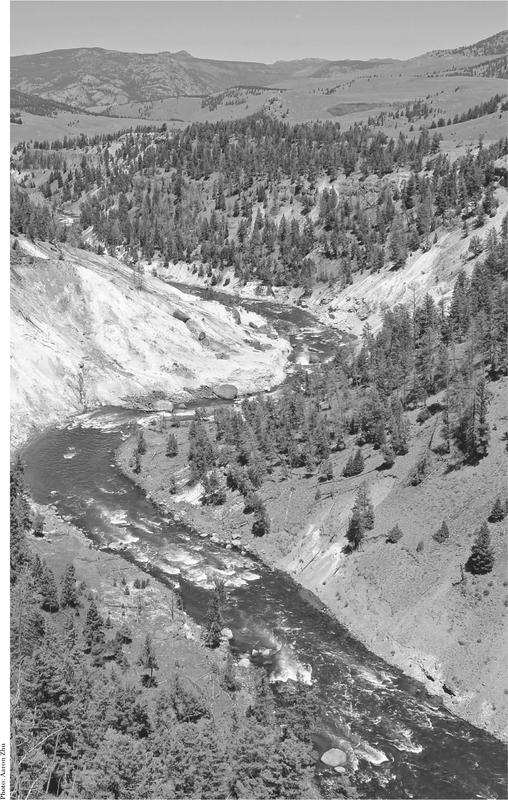
The real wonder of Yellowstone, however, is not one single feature, but the basin as a whole. There are geysers shaped like castle turrets, others like beehives or fountains, even one that looks like a lions head, steam pouring out as it roars. Some scream suddenly, like rockets shooting in the air, others build slowly, bubbling like a witchs brew. There are mud pots the colour of cinnamon and scalding pools edged in slicks of amber and green, like a watercolour painting.
Font size:
Interval:
Bookmark:
Similar books «The 50 Greatest National Parks of the World»
Look at similar books to The 50 Greatest National Parks of the World. We have selected literature similar in name and meaning in the hope of providing readers with more options to find new, interesting, not yet read works.
Discussion, reviews of the book The 50 Greatest National Parks of the World and just readers' own opinions. Leave your comments, write what you think about the work, its meaning or the main characters. Specify what exactly you liked and what you didn't like, and why you think so.

